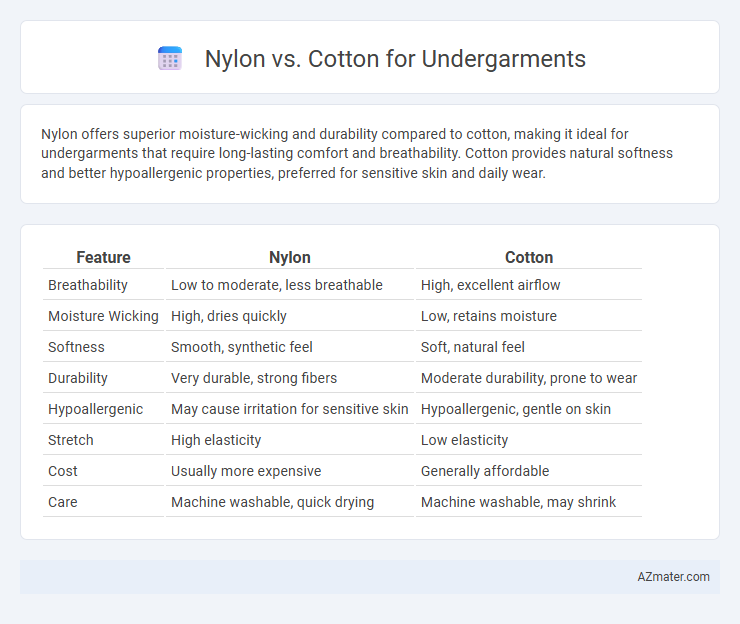Nylon offers superior moisture-wicking and durability compared to cotton, making it ideal for undergarments that require long-lasting comfort and breathability. Cotton provides natural softness and better hypoallergenic properties, preferred for sensitive skin and daily wear.
Table of Comparison
| Feature | Nylon | Cotton |
|---|---|---|
| Breathability | Low to moderate, less breathable | High, excellent airflow |
| Moisture Wicking | High, dries quickly | Low, retains moisture |
| Softness | Smooth, synthetic feel | Soft, natural feel |
| Durability | Very durable, strong fibers | Moderate durability, prone to wear |
| Hypoallergenic | May cause irritation for sensitive skin | Hypoallergenic, gentle on skin |
| Stretch | High elasticity | Low elasticity |
| Cost | Usually more expensive | Generally affordable |
| Care | Machine washable, quick drying | Machine washable, may shrink |
Introduction: Nylon vs Cotton for Undergarments
Nylon and cotton are two popular fabrics commonly used in undergarments, each offering distinct benefits. Nylon provides strong durability, moisture-wicking properties, and a smooth, lightweight feel ideal for active wear. Cotton, known for its breathability and natural softness, excels in comfort and hypoallergenic qualities, making it suitable for sensitive skin.
Fabric Composition and Properties
Nylon undergarments are made from synthetic polyamides known for their high strength, elasticity, and moisture-wicking properties, making them durable and ideal for active wear. Cotton fabric, composed of natural cellulose fibers, offers excellent breathability, softness, and hypoallergenic qualities, promoting comfort and skin health. While nylon excels in quick-drying and stretchability, cotton provides superior moisture absorption and temperature regulation.
Comfort and Breathability Comparison
Nylon undergarments offer lightweight durability and moisture-wicking properties, making them suitable for active wear, but they generally lack the breathability of cotton. Cotton excels in comfort and breathability due to its natural fibers, allowing better air circulation and reducing skin irritation, which makes it ideal for everyday wear. The inherent softness and absorbency of cotton contribute to superior comfort compared to the synthetic texture of nylon fabric.
Moisture-Wicking and Absorption Capabilities
Nylon offers superior moisture-wicking properties compared to cotton, efficiently drawing sweat away from the skin to keep undergarments dry during intense activities. Cotton excels in absorption, soaking up moisture but often retaining it, which can lead to discomfort and longer drying times. Choosing nylon over cotton for undergarments enhances comfort by maintaining dryness and reducing irritation in high-sweat conditions.
Durability and Longevity
Nylon undergarments exhibit superior durability compared to cotton due to their resistance to wear, stretching, and moisture absorption, which prolongs fabric lifespan. Cotton, while breathable and comfortable, tends to degrade faster with repeated laundering and exposure to sweat. Choosing nylon enhances longevity in active wear, making it ideal for garments requiring sustained shape and strength.
Skin Sensitivity and Allergenicity
Nylon undergarments, while durable and moisture-wicking, can cause irritation and allergic reactions in individuals with sensitive skin due to their synthetic fibers and chemical treatments. Cotton is hypoallergenic and breathable, making it a preferred choice for those prone to skin sensitivity and allergies, as it reduces the risk of irritation and promotes better airflow. Choosing cotton undergarments can help maintain skin health by minimizing contact with potential allergens commonly found in synthetic fabrics like nylon.
Care, Maintenance, and Washing Requirements
Nylon undergarments require gentle washing with cold water and mild detergents to maintain fabric integrity, avoiding high heat and bleach which can cause damage or discoloration. Cotton undergarments are more durable and can withstand regular machine washing at higher temperatures, but they may shrink or lose shape if not properly air-dried or tumble-dried on low settings. Both fabrics benefit from avoiding fabric softeners to preserve moisture-wicking properties in nylon and breathability in cotton.
Environmental Impact and Sustainability
Nylon is a synthetic fiber derived from petrochemicals, making its production energy-intensive and contributing to greenhouse gas emissions, whereas cotton is a natural fiber but requires significant water and pesticide use in conventional farming practices. Organic cotton offers a more sustainable alternative by reducing chemical inputs and water usage, while nylon is not biodegradable and contributes to microplastic pollution in waterways. Choosing undergarments made from recycled nylon or organic cotton can mitigate environmental impact and support sustainability goals.
Cost Differences and Value for Money
Nylon undergarments generally cost less than cotton options due to lower production expenses and synthetic fiber sourcing. Cotton offers superior breathability and comfort, providing better value over time despite a higher initial price. Choosing between nylon and cotton depends on balancing immediate affordability against longer-term comfort and durability benefits.
Final Verdict: Choosing the Best Undergarment Fabric
Nylon undergarments offer superior moisture-wicking, durability, and stretch, making them ideal for active lifestyles and long-lasting wear. Cotton undergarments excel in breathability and natural softness, providing comfort and hypoallergenic benefits for sensitive skin. Selecting the best fabric depends on personal priorities: prioritize nylon for performance and longevity or cotton for comfort and skin-friendly qualities.

Infographic: Nylon vs Cotton for Undergarment
 azmater.com
azmater.com